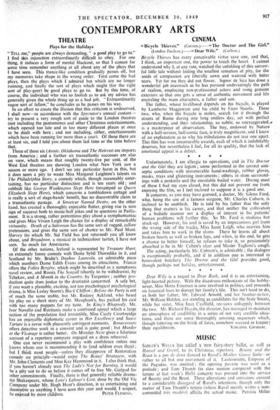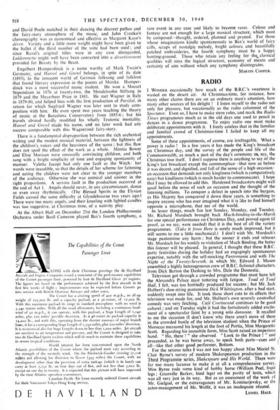MUSIC
SADLER'S WELLS has added a new fairy-story ballet, as well as Hansel and Gretel. to its Christmas repertory. Beauty and the Beast is a pas de deux danced to Ravel's Mother Goose Suite—or rather to all but one movement of it. Laideronette, Empress of the Pagodas, was omitted ; the opening pavane was used as a prelude ; and Tom Thumb (in slow motion compared with the tempo at last week's Halle concert) was pressed into the service of Beauty and the Beast. These alterations and omissions amount to a considerable disregard of Ravel's intentions, though only the matter of Tom Thumb's tempo (where Ravel merely writes a non- committal ties strodere) affects the actual music. Patricia Miller
and David Poole matched in their dancing the discreet pathos and the fairy-story atmosphere of the music, and John Cranko's choreography was as economical and effective as Margaret Kaye's decor. Variety and a little more weight might have been given to the ballet if the third number of the suite had been used ; and since Ravel's original titles were in any case disregarded, Laideronette might well have been converted into a divertissement provided for Beauty by the Beast.
Engelbert Humperdinck is a name worthy of Mark Twain's Germany, and Hansel and .Gretel belongs, in spite of its date (1893), to the innocent world of German folksong and folklore that found literary expression in the poems of MOrike. Humper- dinck was a most successful music student. He won a Mozart Stipendium in 1876 at twenty-two, the Mendelssohn Stiftung in 1879 and the Isleyerbeer Prize in 1881. He met Wagner in Italy in 1879-80, and helped him with the first production of Parsifal, in return for which Siegfried Wagner was later sent to study com- position with him. He even spent two years teaching the theory of music at the Barcelona Conservatory from 1885-6 ; but his travels abroad hardly modified his wholly Teutonic mentality. Hansel and Gretel made his name, and no later work had any success comparable with this Wagnerised fairy-story.
There is a fundamental disproportion between the rich orchestral writing and the modest musical material, between the lightness of the children's voices and the heaviness of the score ; but this flaw does not spoil the effect of the work as a whole. Minnia Bower and Elsie Morison were unusually convincing children, and both sang with a bright simplicity of tone and engaging spontaneity of manner. Valetta Jacopi had only one fault as the Witch: her words were inaudible, so that the details of her scheme for fattening and eating the children were not clear to the younger members of the audience. Otherwise she was comical and sinister in the right proportions. A serious fault in the production occurred at the end of Act I. Angels should never, in any circumstances, dance or even sway rhythmically. (The Blessed Spirits in the Elysian Fields caused the same difficulty at Glyndebourne two years ago.) There were too many angels, and their kneeling with lighted candles was too suggestive, at Christmas time, of a nativity play.
At the Albert Hall on December 21st the London Philharmonic Orchestra under Basil Cameron played Bax's fourth symphony, a rare event in any case and likely to become rarer. Colour and fantasy are not enough for a large musical structure, which must be composed—thought, ordered, planned and pruned. For those whose imaginations kindle spontaneously in Bax's world of fairy calls, scraps of nostalgic melody, bright colours and beautifully patched embroideries, the fourth symphony must be a happy hunting-ground. Those who retain any feeling for the, classical qualities will miss the logical structure, economy of means and certainty of aim without which any symphony disintegrates.
MARTIN COOPER.































 Previous page
Previous page